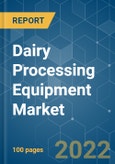Dairy processing equipment market is projected to grow at a CAGR of 5.21% during the forecast period (2020-2025).
Key Highlights
- The long-term growth and outlook for dairy products and its equipment is positive, given the new product development and portfolio expansion, the dairy equipment market is thriving on growing demands for healthful indulgent products.
- The growth in the demand for functional dairy-based ingredients and convenient products, such as protein concentrates, whey-based supplements are driving the sales of drying and dehydration systems. The sales growth of fortified dairy products, in the form of infant nutrition and geriatric nutrition formulae, demanding highest level of purity has intensified the sales of filtration systems.
- The fortification trend has also amplified the demand and consequent sales of mixing and blending equipment.
Key Market Trends
Homogenizers Dominates the Market
Homogenizers are projected to play key role in the processing of dairy based products. It is a mechanical process used to reduce the size of the fat globules in the milk. The key players operating in the market studied are launching innovative homogenizers owing to its higher demand for varied application. In September 2017, GEA launched the GEA Ariete Homogenizer 5400, the world’s most powerful homogenizer. The homogenizer consist of 5 pistons that can process 80,000 liters of milk per hour at 120 bar, providing a quarter more power compared to other machines. Therefore, the continuous innovation in the sector drives the market studied.
Asia-Pacific is the Fastest as well as the Largest Market
Asia-Pacific accounts for the largest share of the market studied owing to numerous dairy processing plants in the region as well as the high production of milk, especially from India, China, and Pakistan. In the region, dairy products are touted as a convenient and relatively cheap source of protein and this has increased their availability, accessibility, and wider geographic penetration. The traditional dairy-based drinks still hold dominance in the region necessitating the increased utility of plate heat exchangers, the popularity of indulgent and viscous dairy products have also increased the demands for tubular heat exchangers. Moreover, the strong demand for dairy-based powders for incorporation in foods for special dietary purposes, particularly in the markets of Thailand, China, and Singapore are driving the growth of highly efficient drying and dehydration systems.
Competitive Landscape
The global market of dairy processing equipment faces a strong challenge in the form of high operating costs. Companies, such as Tetra Pak, have introduced energy-efficient separators with a reduction of as much as 40% of energy requirement by installing pressure management technology. Tetra Pak also introduced a “Plant Secure” plant management service that addresses the issues of operational expenditures throughout the value chain. The companies are also embarking on acquisitions in order to further refine their expertise within specific equipment types. For instance, Tetra Pak recently acquired Big Drum Engineering GmbH, a leading supplier of filling machines for the ice cream industry.
Additional Benefits:
- The market estimate (ME) sheet in Excel format
- 3 months of analyst support
This product will be delivered within 2 business days.
Table of Contents
Methodology

LOADING...








